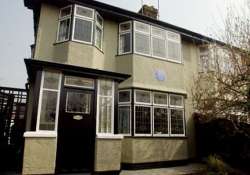Lennon, McCartney Former Homes To Be Preserved
London, Feb 29: The childhood homes of former Beatles John Lennon and Paul McCartney, where the pair wrote some of their early songs, will be preserved, the government said Wednesday.Lennon's house in south Liverpool and

London, Feb 29: The childhood homes of former Beatles John Lennon and Paul McCartney, where the pair wrote some of their early songs, will be preserved, the government said Wednesday.
Lennon's house in south Liverpool and McCartney's nearby row home will be granted a grade 2 listing, which means they cannot be altered without the permission of local officials, said Britain's Heritage Minister John Penrose.
The decision means the homes of one of Britain's greatest songwriting teams will be protected for generations to come. Their work has long been associated with the northern port city Liverpool, particularly because of songs like “Penny Lane” and “Strawberry Fields Forever” that celebrated their childhood haunts.
Lennon lived at a comfortable 1930s duplex house called “Mendips” in 251 Menlove Ave. from 1945 to 1963 with his aunt and uncle after his parents separated when he was five.
McCartney lived in nearby Forthlin Road for nine years from 1955. The two musicians held early practice sessions for their first band The Quarrymen while living at these houses, and wrote The Beatles first number one hit, the raucous “Please Please Me,” at Lennon's home.
Preservation group The National Trust has already restored the houses to look as they would have done when Lennon and McCartney were growing up.
In a statement Wednesday, Lennon's widow Yoko Ono said: “Mendips always meant a great deal to John and it was where his childhood dreams came true for himself and for the world.”
The preservation order was granted by English Heritage, a government-sponsored body that decides which buildings to preserve. It decided not to preserve the childhood homes of Beatles lead guitarist George Harrison and drummer Ringo Starr.
Emily Gee at English Heritage said Lennon's and McCartney's homes had been preserved because “they were scenes of huge amounts of rehearsal, of composition of songs, really intense creative hubs.”